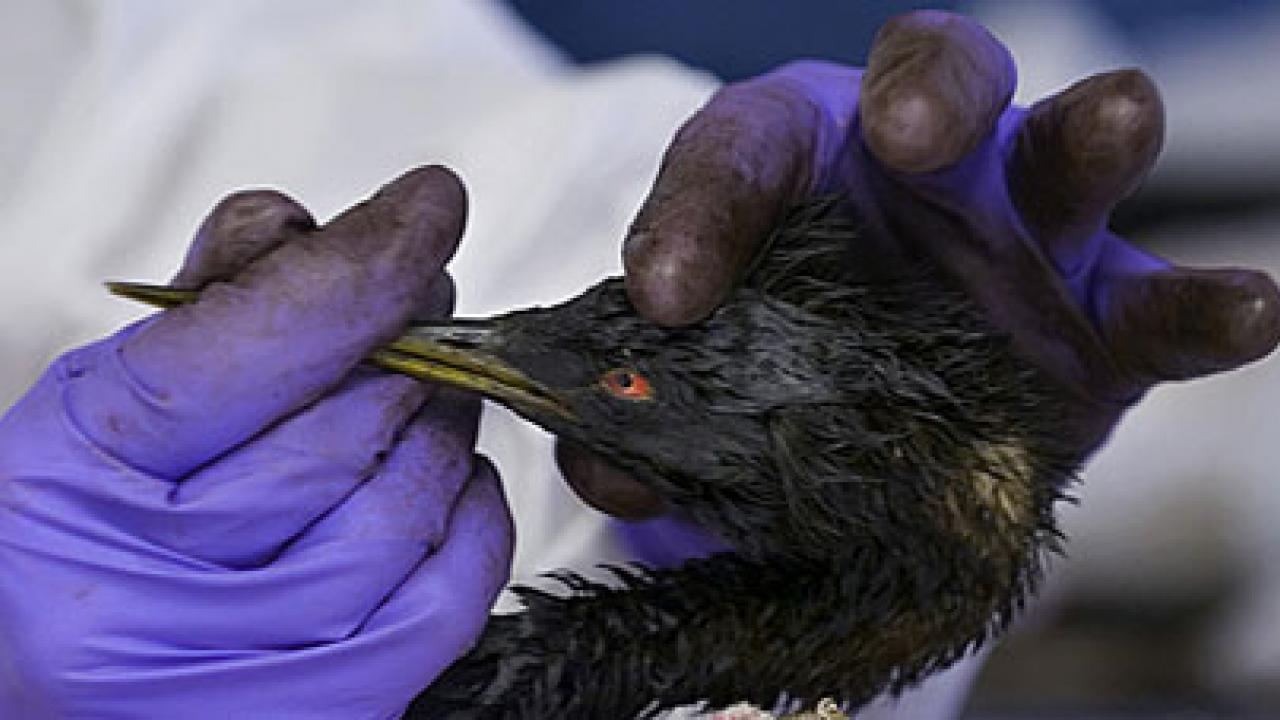One year after leading the second-largest rescue and rehabilitation of oiled seabirds in recent California history, UC Davis wildlife health experts are busy preparing for the next major oil spill.
"Our care for the wildlife affected by the Cosco Busan spill in San Francisco Bay demonstrated the excellence of the Oiled Wildlife Care Network as a whole," said UC Davis wildlife veterinarian Michael Ziccardi, who directs the network. "It showed that a trained staff of dedicated professionals and volunteers, using research-based medicine in pre-established facilities, can save the lives of hundreds of animals that otherwise would have died."
However, the rescue operation also revealed areas in the program that could be improved, Ziccardi said. "The infrastructure in place in California, following our four core tenets of readiness, response, research and reaching out, is truly not matched anywhere in the world. But our mission is to provide the best care possible to oiled wildlife, and with each spill, we learn how to make the 'best care possible' better."
Ziccardi directed the care of birds of 31 species that were injured when more than 53,000 gallons of fuel oil spilled from the container ship Cosco Busan into San Francisco Bay on Nov. 7, 2007. Of 1,068 oiled birds collected alive, 418 birds (38.5 percent) were saved and later released back to the wild.
While lower than the typical 50 to 75 percent release rate that the network averages for California spills, Ziccardi said he considers this a success because "the spill occurred in the winter months (when birds are in poor condition), affected very stress-sensitive species, and affected a lot of birds -- each of which makes it very difficult to repair the damage the oil causes."
(The network team also processed 965 birds that were dead when collected and later were determined to have died of oil-related causes.)
The injured birds were treated at the San Francisco Bay Oiled Wildlife Care and Education Center in Fairfield, a 12,000-square-foot, $2.7 million facility capable of caring for up to 1,000 sick birds. It is the major Northern California rescue center in the statewide Oiled Wildlife Care Network, which is made up of 12 facilities and 25 local organizations that stand ready to care for oiled wildlife on short notice.
The Oiled Wildlife Care Network is California's spill-response program. It is managed by the UC Davis Wildlife Health Center, which is a program of the UC Davis School of Veterinary Medicine. It is funded by the Office of Spill Prevention and Response of the California Department of Fish and Game. The Fish and Game monies come from interest on the $50 million California Oil Spill Response Trust Fund, built from assessments on the oil industry.
This week, reflecting on the busy year since the spill, network director Ziccardi listed some of the lessons learned:
Ziccardi said that since the network was established in 1994, it had made great progress in learning how to treat oiled animals, and in applying that knowledge during spills. Now, he continued, the same level of effort is needed to further develop emergency plans and train personnel for animal collection, "so we can get those injured animals off beaches and into treatment as soon as possible."
California Assembly Bill 2911, introduced in the 2008 legislative session by state Assemblymember Lois Wolk (D-Davis), officially adds that responsibility to the Oiled Wildlife Care Network's legislative mandate and allocates Spill Response Trust monies to fund it.
A full-time recovery and transportation coordinator was hired in September and has begun this process by first developing recruitment and training programs. The program will be expanded once the provisions of AB 2911 fully come into effect in 2009. The coordinator is Nils Warnock, an expert on ecology and conservation of birds in the Pacific Flyway.
In the first hours after the Cosco Busan spill, the network's established corps of professional and volunteer wildlife rehabilitators began assembling at their pre-assigned duty stations. In the two months that followed, these trained individuals continued to provide the necessary medical care, feeding and washing for the more than 1,000 birds that were collected. Eventually 450 pre-trained rehabilitators, all affiliated with the Oiled Wildlife Care Network's 25 member organizations, worked on the Cosco Busan response.
But there were more than 1,000 other people who were moved to volunteer after seeing news reports about the spill, and they initially overwhelmed telephone and online communications. Even so, 500 so-called "convergent volunteers" were soon enrolled, trained and set to work in key support roles at the rescue center, such as building bird pens, cutting up frozen fish, doing laundry and reading blood tests.
A full-time coordinator of volunteers and outreach programs was hired in August and has begun improving the network's public-information practices, including revamping volunteer information pages on the network's Web site. The coordinator is Kaiti Ferguson, who previously worked in communications at Los Alamos National Laboratory and a leading private communications firm in the Bay Area.
Soft-sided bird pens developed by UC Davis staff were tested during the spill. These, plus protective booties and cushions, helped reduce the number of injuries and ulcers that birds developed on their feet, wings and keels (breast bones).
Other research studies continue, including tests of infrared thermographic imaging to better manage feather waterproofing after birds are cleaned; understanding the source of potentially fatal fungal infections; and a post-release survival study using the radio-tracking of scoters to learn where released birds go and how long they live when compared to un-oiled birds.
- A greater number of qualified, prepared people are needed for search and collection efforts.
- Members of the public need better information about how they can help.
- Research and technology innovation continue to improve survival rates.
Media Resources
Michael Ziccardi, Wildlife Health Center, (530) 752-4167, mhziccardi@ucdavis.edu
